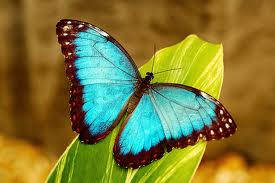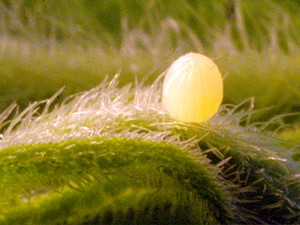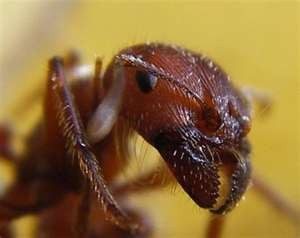 Spruce budworm is one of the most damaging native insects of spruces and true fir in the USA and Canada. Their food of choice is conifers mainly balsam fir, white spruce, and red spruce. During light or moderate infestations, the damage is restricted to a partial loss of new foliage, particularly in the upper crown of the tree. During a major outbreak, tens of millions of hectares of trees can be severely defoliated by the insect. This, in turn, can result in significant losses of important timber and non-timber resources, negatively affecting the forest industry and forestry-dependent communities. Spruce budworm outbreaks have devastated huge areas of forests on a more or less regular basis since the 18th century.
Spruce budworm is one of the most damaging native insects of spruces and true fir in the USA and Canada. Their food of choice is conifers mainly balsam fir, white spruce, and red spruce. During light or moderate infestations, the damage is restricted to a partial loss of new foliage, particularly in the upper crown of the tree. During a major outbreak, tens of millions of hectares of trees can be severely defoliated by the insect. This, in turn, can result in significant losses of important timber and non-timber resources, negatively affecting the forest industry and forestry-dependent communities. Spruce budworm outbreaks have devastated huge areas of forests on a more or less regular basis since the 18th century.
Spruce budworms and its relatives are a group of closely related insects in the genus Choristoneura. There are nearly forty Choristoneura species, and even more subspecies, or forms, with a complexity of variation among populations found throughout much of the United States and Canada, and about again this number in Eurasia.
 Adult moths are about 1/2 inch (12.7 mm) long and have a wing-spread of 7/8 to 11/8 inches (22 to 28mm). Moths of both sexes are similar in appearance, although the females are a bit more robust than males. Both sexes fly. The gray- or orange-brown forewings are banded or streaked, and each usually has a conspicuous white dot on the wing margin. Eggs are oval, light green, and about 3/64 inch (1.2mm) long and overlap like shingles. The adults mate, and within 7 to 10 days, the female deposits her eggs and then dies. Each female deposits approximately 150 eggs, usually on the underside of conifer needles. Eggs are laid in one to three-row masses containing a few to 130 eggs, with an average of 25 to 40 eggs per mass. Larvae hatch from eggs in about 10 days. Larvae do not feed but seek sheltered places under bark scales or in and among lichens on the tree bole or limbs. Here, they spin silken tents in which they remain inactive through the winter.
Adult moths are about 1/2 inch (12.7 mm) long and have a wing-spread of 7/8 to 11/8 inches (22 to 28mm). Moths of both sexes are similar in appearance, although the females are a bit more robust than males. Both sexes fly. The gray- or orange-brown forewings are banded or streaked, and each usually has a conspicuous white dot on the wing margin. Eggs are oval, light green, and about 3/64 inch (1.2mm) long and overlap like shingles. The adults mate, and within 7 to 10 days, the female deposits her eggs and then dies. Each female deposits approximately 150 eggs, usually on the underside of conifer needles. Eggs are laid in one to three-row masses containing a few to 130 eggs, with an average of 25 to 40 eggs per mass. Larvae hatch from eggs in about 10 days. Larvae do not feed but seek sheltered places under bark scales or in and among lichens on the tree bole or limbs. Here, they spin silken tents in which they remain inactive through the winter.
 The native spruce budworm is a major defoliator of conifer forests, where it attacks mainly balsam fir and spruces and occasionally other conifer species. In the mid-1980s, the spruce budworm destroyed more than 10 million cubic meters of wood in Quebec, Canada alone. The larvae are to be blamed for this. The first mine or tunnel into year-old needles closed buds or newly developing vegetative or reproductive buds. Larvae prefer buds but will also attack old needles. The first symptoms of damage are usually frass and silk webs in buds or on last year’s needles. Tree crowns may appear brown as a result of partly chewed needles, dead buds and frass being webbed together and thus held at branch tips to dry. During outbreaks, it is common to see large numbers of caterpillars hanging from the ends of silk threads. This allows them to spin further down the tree canopy, or to be carried considerable distance by air currents. In light infestations, partial loss of new foliage, particularly in the upper crown, may occur. In heavier infestations, more serious defoliation may result. Defoliation for three years or more will reduce tree vitality and may produce top kill of leaders and some terminal branch shoots. Five to seven successive years of defoliation will lead to tree mortality. A single, complete defoliation commonly kills conifers.
The native spruce budworm is a major defoliator of conifer forests, where it attacks mainly balsam fir and spruces and occasionally other conifer species. In the mid-1980s, the spruce budworm destroyed more than 10 million cubic meters of wood in Quebec, Canada alone. The larvae are to be blamed for this. The first mine or tunnel into year-old needles closed buds or newly developing vegetative or reproductive buds. Larvae prefer buds but will also attack old needles. The first symptoms of damage are usually frass and silk webs in buds or on last year’s needles. Tree crowns may appear brown as a result of partly chewed needles, dead buds and frass being webbed together and thus held at branch tips to dry. During outbreaks, it is common to see large numbers of caterpillars hanging from the ends of silk threads. This allows them to spin further down the tree canopy, or to be carried considerable distance by air currents. In light infestations, partial loss of new foliage, particularly in the upper crown, may occur. In heavier infestations, more serious defoliation may result. Defoliation for three years or more will reduce tree vitality and may produce top kill of leaders and some terminal branch shoots. Five to seven successive years of defoliation will lead to tree mortality. A single, complete defoliation commonly kills conifers.
The availability of extensive forests of susceptible host trees is a primary contributor to the development of widespread outbreaks, mostly by supporting the survival of small larvae and maturation of moths that reproduce and migrate to new areas. The last extensive outbreak of spruce budworm in Canada reached its peak in the 1970s, damaging more than 50 million hectares. The steady increase in the area of forest damaged by spruce budworm has been observed in eastern Canada since 2006, perhaps heralding a new, extensive outbreak in that part of the country. The damage caused by this worm goes into millions of dollars annually in the USA as well as Canada.
Let us see the following news article:
Bracing for spruce budworm assault
Chris Morris
Legislature Bureau
18 Jul 2013 07:46 AM
FREDERICTON – Researchers are hunting for ways to outmaneuver the spruce budworm as the insects begin massing for a major assault on the forests of New Brunswick and eastern Canada. Rob Johns, a researcher with the Canadian Forest Service in Fredericton, said Wednesday the budworm outbreak in Quebec is expanding and there are fears the infestation could spread into New Brunswick in the near future.“It will come pretty quickly when it does come,” Johns said in an interview. He said he was looking at video sent to him earlier this week of a mass migration of budworm moths across the St. Lawrence River to Rimouski.
“There were millions flying around in this parking lot to the point where you could scoop them up in your hands,” he said. Johns said the budworms have caused severe to moderate damage over as much as six million hectares of Quebec forest so far. He said the outbreak has been roughly doubling since it first began in the Baie Comeau area in 2006. Spruce budworm is a forest insect pest native to North America whose larva feed on balsam fir and spruce trees. Historically, outbreaks have occurred every 30 to 50 years in northeastern North America.
The last outbreak of spruce budworm began in roughly the 1970s. The last significant spruce budworm damage observed in New Brunswick occurred in 1995.
Johns said that during the last major outbreak, 51 million hectares were infested throughout northeastern North America and “40 percent of the trees hit heavily by the budworm died.”
“The spruce budworm caused significant tree mortality and volume loss during the last outbreak,” the New Brunswick Department of Natural Resources said in a statement.
“It is uncertain at this point how severe the next outbreak will be in New Brunswick. However, we can expect that an uncontrolled spruce budworm outbreak will cause damage to our spruce and fir forests, resulting in potentially significant reductions to the amount of timber volume available for harvest and possible impacts on other forest values such as old spruce-fir wildlife habitat.” There are predictions a spruce budworm infestation could begin in earnest in New Brunswick in two years. The infestation in Quebec has reached the Gaspe, just a few kilometers from the New Brunswick border. Johns said governments, researchers and industry want to be prepared for the spruce budworm infestation this time and are studying ways to minimize the impact.
“The idea right now is we’re hoping that if we can start treating populations at low densities before they actually get to these huge epidemic levels then we can possibly keep them at bay and maintain a low level of infection,” he said.
“We are starting to test this early intervention strategy where we are actually trying to treat some of these very small populations.”
Johns said tests on small areas are being conducted in Quebec, but it is still too early to say whether it will be effective.
It’s expected the Madawaska region will likely be the first hit in New Brunswick.
Spraying for the spruce budworm costs approximately $80 per hectare. For a moderate outbreak, spraying could cost up to $80 million or, in the event of a crisis, roughly $200 million.
The cost would likely be split between different levels of government and industry.
The budworm problem has been consistent and pestering one for the past several years. North America and especially Canada has suffered a lot due to this pesky pest. The hectares of forest land lost to this pest are on the increase and will further continue if appropriate steps are not taken. The outbreak of budworm infestation is quite sudden without a preamble.
Hence to help alleviate or else completely eradicate the infestation we C Tech Corporation provide you with the best effective solution Combirepel™ . Combirepel™ is an anti-insect aversive developed on the grounds of green chemistry and technology.
Our product works on the mechanism of repellency. It temporarily inhibits the mating cycle of the insects. The product impairs the ability of the insects to reproduce, that is the insects will not lay eggs or the laid eggs will be infertile. The product causes feeding disruption in an insect by triggering an unpleasant reaction within the insect which might try to feed on the application. The product temporarily blocks the reproduction system of the insects by hindering the release of the vital hormones for growth.
Combirepel™ is thermally stable and does not degrade on exposure to heat and sunlight. It does not kill or harm the insect but repels them. It does not volatilize and does not degrade the soil. It is RoHS, RoHS2, ISO, REACH, APVMA, NEA compliant and FIFRA exempted.
Combirepel™ is an eco-friendly product which acts as an aversive to repel the pesky insects like roaches. Combirepel™ do not kill the targeted as well as non-targeted species but just repel them causing no harm any to human and environment.
Combirepel™ is available in the form of the masterbatch, liquid concentrate, and lacquer. Our Combirepel™ masterbatch can be used in polymer base applications like wires, cables, irrigation pipes, polymeric vessels, and other various applications.
Combirepel™ liquid concentrate can be mixed in the paints to cover the areas like cracks and crevices of walls and hidden places where the roaches tend to survive.
Combirepel™ lacquer is the topical coating to cover the places like bathrooms, cupboards, steam tunnels, etc.
Hence we provide you with the best effective solution.
Contact us as technical.marketing@ctechcorporation.com to get solution on pest nuisance.
Also, visit our websites:
http://www.ctechcorporation.com/
http://www.rodrepel.com/
http://www.termirepel.com/
http://www.combirepel.com/
Follow our Facebook pages at:
1] https://www.facebook.com/Combirepel-411710912249274/
2] https://www.facebook.com/Termirepel-104225413091251/
3] https://www.facebook.com/Rodrepel-120734974768048/
Follow us on our Twitter pages at:
1] https://twitter.com/rodrepel
2] https://twitter.com/termirepel
3] https://twitter.com/combirepel














